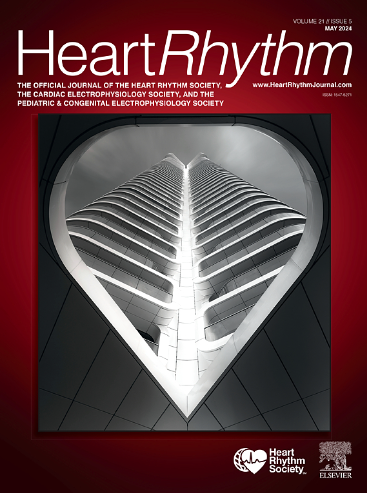Ineffective cardiac resynchronization pacing is associated with poor outcomes in a nationwide cohort analysis
IF 5.6
2区 医学
Q1 CARDIAC & CARDIOVASCULAR SYSTEMS
引用次数: 0
Abstract
Background
Delivery of cardiac resynchronization therapy (CRT) requires left ventricular myocardial capture to achieve clinical benefits.
Objective
We sought to determine whether ineffective pacing affects survival.
Methods
Ineffective ventricular pacing (VP) was defined as the difference between the percentage of delivered CRT (%VP) and the percentage of effective CRT in CRT devices. Using the Optum de-identified electronic health record data set and Medtronic CareLink data warehouse, we identified patients implanted with applicable devices with at least 30 days of follow-up. Kaplan-Meier and Cox proportional hazards models assessed the impact of %VP and % ineffective VP on survival.
Results
Among 7987 patients with 2.1 ± 1.0 years of follow-up, increasing ineffective VP was associated with decreasing survival: the highest observed survival was in the quartile with <0.08% ineffective VP and the lowest survival was in the quartile with >1.47% ineffective VP (85.1% vs 75.7% at 3 years; P < .001). As expected, patients with more than the median %VP of 97.7% had better survival than did patients with <97.7% VP (84.2% vs 77.8%; P < .001). However, patients who had >97.7% VP but >2% ineffective VP had similar survival to patients with <97.7% VP but ≤2% ineffective VP (81.6% vs 79.4%; P = .54). A multivariable Cox proportional hazards model demonstrated that <97.7% VP (adjusted hazard ratio 1.29; 95% confidence interval 1.14–1.46; P < .001) and >2% ineffective VP (hazard ratio 1.35; 95% confidence interval 1.18–1.54; P < .001) were both significantly associated with decreased survival.
Conclusion
Ineffective VP is associated with decreased survival. In addition to maximizing the percentage of delivered CRT pacing, every effort should be made to minimize ineffective VP.
在一项全国队列分析中,无效心脏再同步起搏与不良预后有关。
背景:心脏再同步化治疗(CRT)需要捕获左心室心肌才能获得临床疗效:我们试图确定无效起搏是否会影响存活率:方法:无效心室起搏(VP)定义为 CRT 设备的 CRT 交付百分比(%VP)与 EffectivCRTTM 百分比之间的差异。利用 Optum® 去标识化电子病历数据集 (Optum® EHR) 和美敦力 CareLinkTM 数据仓库,我们确定了植入适用设备且随访至少 30 天的患者。Kaplan-Meier和Cox比例危险模型评估了%VP和%无效VP对生存的影响:在随访 2.1±1.0 年的 7,987 名患者中,无效 VP 的增加与生存率的下降有关:观察到的最高生存率出现在无效 VP 为 1.47% 的四分位患者中(3 年时 85.1% vs. 75.7%,p97.7%),但无效 VP >2% 的患者与无效 VP 为 2% 的患者的生存率相似(HR 1.35;95% CI 1.18-1.54;p结论:无效 VP 与生存率下降有关:无效VP与生存率下降有关。除了最大限度地提高 CRT 起搏的比例外,还应尽力减少无效 VP。
本文章由计算机程序翻译,如有差异,请以英文原文为准。
求助全文
约1分钟内获得全文
求助全文
来源期刊

Heart rhythm
医学-心血管系统
CiteScore
10.50
自引率
5.50%
发文量
1465
审稿时长
24 days
期刊介绍:
HeartRhythm, the official Journal of the Heart Rhythm Society and the Cardiac Electrophysiology Society, is a unique journal for fundamental discovery and clinical applicability.
HeartRhythm integrates the entire cardiac electrophysiology (EP) community from basic and clinical academic researchers, private practitioners, engineers, allied professionals, industry, and trainees, all of whom are vital and interdependent members of our EP community.
The Heart Rhythm Society is the international leader in science, education, and advocacy for cardiac arrhythmia professionals and patients, and the primary information resource on heart rhythm disorders. Its mission is to improve the care of patients by promoting research, education, and optimal health care policies and standards.
 求助内容:
求助内容: 应助结果提醒方式:
应助结果提醒方式:


